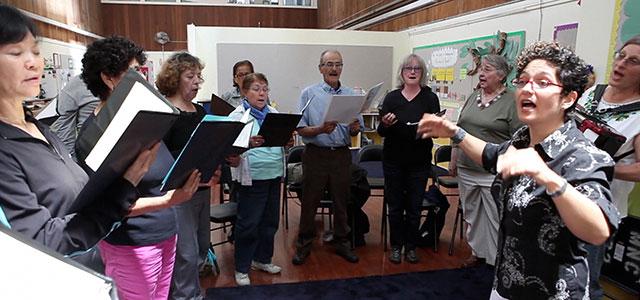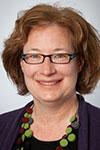
A choir of seniors at San Francisco’s Mission Neighborhood Centers is led by Community of Voices Choir conductor Martha Rodriguez-Salazar (still from video by Elisabeth Fall).
Let the Choir Sing: Lifting Our Voices for Healthy Aging
With today’s growing population of medically vulnerable older adults and the escalating costs of health care, what if measurable health benefits for the elderly were as simple as weekly rounds of “Messiah” or “Ave Maria” with friends?
Julene Johnson, a cognitive neuroscientist and professor at UC San Francisco School of Nursing’s Institute for Health & Aging, thinks such benefits are possible, even likely. Her belief is based on a small but intriguing body of research – including some by Johnson herself – correlating health improvements in seniors with choir singing.
 Julene Johnson Now she is testing the hypothesis further in a multiyear, NIH-funded study of 12 community choirs based at senior centers in culturally diverse San Francisco neighborhoods.
Julene Johnson Now she is testing the hypothesis further in a multiyear, NIH-funded study of 12 community choirs based at senior centers in culturally diverse San Francisco neighborhoods.
The study, launched in April, is a collaboration among Johnson, the San Francisco Department of Aging and Adult Services and the San Francisco nonprofit Community Music Center. It will evaluate a variety of health outcomes – such as balance, lower body strength, depressive symptoms, loneliness and memory – by comparing choir participants with a randomized control group that waits six months to start singing.
Among those watching closely are funders at the National Institute on Aging (NIA), one of the 27 institutes and centers of the NIH, their colleagues at the National Endowment for the Arts (NEA) and the National Guild for Community Arts Education, who point to the study as a perfect example of their new effort to spearhead more rigorous investigation of the nexus of the arts and health.
“The goal is to provide scientific-based evidence that community arts programs can be used to promote health,” Johnson says. “Everyone says, ‘Yes, of course I know they’re good for us,’ but we don’t have enough evidence yet.”
Building the Research
Johnson’s choirs reflect San Francisco’s growing population of culturally diverse, lower-socioeconomic residents. Professional music directors from the Community Music Center tailor each choral program to the predominant cultural background of each group, including Latino, African American and Asian American residents. The choirs, whose participants are age 60 and over, are randomly assigned to start either immediately or after a six-month delay to create a nonsinging control group. The researchers assess the participants at baseline and then at six months and one year.
Johnson hopes to expand on a breakthrough 2006 study conducted by the late geriatric psychiatrist Gene Cohen. His study found that people age 65 or older participating in weekly community arts programs, including choir, had fewer trips to the doctor, used fewer medicines, fell less, expressed less loneliness and were more active than control groups.
Cohen’s study included participation in creative writing, painting and other fine arts. By focusing more narrowly on choir singing, Johnson – who has a research specialty in brain health and aging – wants to further a body of work that links exposure to music to cognitive benefits.
She is also a musician who plays flute, sang in choirs for years and is now learning a Finnish folk instrument called a kantele. “I’ve always had this interest in weaving creativity and music into my research,” she says.
But she’s mainly studying choirs because they’re easy for almost anyone to join – a major plus for community health promotion.
“Singing in a choir doesn’t require a lot of prior musical training. One doesn’t even need to know how to read music notation. Also, singing is a big part of many cultures, which is another thing that makes it very accessible,” she says.
The Right Time for the Arts and Health
Johnson’s San Francisco study builds on her research as a 2010 Fulbright Scholar in Finland, which found a strong correlation between the quality of life of seniors and choir singing, especially in their social and psychological well-being (in press, International Psychogeriatrics).
After returning from Finland, Johnson was eager to deepen her choir work. She found kindred spirits at the Community Music Center, which offers a range of lessons on a sliding scale, and San Francisco’s Department of Aging and Adult Services. Their collaboration won the NIH funding.
All are interested in finding inexpensive, easily accessible ways to enhance the lives of seniors, a US population projected to more than double between 2010 and 2050, from 40.2 million to 88.5 million, according to the US Census Bureau. Johnson’s study includes a cost analysis of running choirs.
Her timing was good, because in 2011 the NIH and the NEA launched a multiagency task force to promote research on the arts and human development, prompted by a mutual interest of former NEA Chairman Rocco Landesman, who retired at the end of 2012, and US Secretary of Health and Human Services Kathleen Sebelius.
The task force, which hopes to drive research but isn’t a direct funder, held its first workshop in September 2012 on the arts, health and well-being in older Americans. Johnson was there.
“What’s exciting and transformative about her study is that it’s looking at community-based arts from an interesting methodological perspective,” says Sunil Iyengar, the NEA’s director of the Office of Research and Analysis. “Research of this stature is something there’s a big appetite for.”
Not only is Johnson attracting NIH funding, which Iyengar called “no easy feat,” but also her partnerships with community groups set the stage for precisely the type of easily replicated community-based program the task force wants to promote.
Lis Nielsen, chief of the NIA’s Individual Behavioral Processes Branch in the Division of Behavioral and Social Research, agrees. The institute, a task force partner, hasn’t historically supported much research on health and the arts, but this is changing.
“There does seem to be a growing interest in such programs,” says Nielsen. “We understand that healthy aging involves not only advances in biomedical science, but also interventions in people’s everyday lives to promote healthy behaviors. If it turns out that arts participation has positive health effects, this would be important news for communities and institutions that want to support programs for older adults.”
Johnson’s study is well designed, Nielsen says. “Projects that can demonstrate cost-effectiveness and the potential to reach a large population are more likely to generate support.”
If Johnson’s hypothesis proves correct, and regular singing with peers boosts the health of San Francisco seniors, perhaps the United States will become more like Finland, which has a rich historic tradition of community choirs.
“This is potentially inexpensive, can be translated to lots of settings and is pretty easy to sustain,” says Johnson. “We tend to be limited in what we think people should be doing when they’re older, [but] the potential for creativity in the advanced years is enormous, and often goes untapped. This needs to change.”



